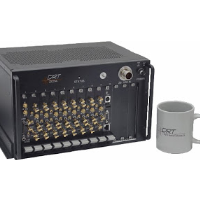LAPD Has Had “Stingray on Steroids” Surveillance Equipment for a Decade
 An older version of seldom-seen "dirtbox"
An older version of seldom-seen "dirtbox"
Secret Stingray cellphone surveillance technology, deployed by police departments without warrants across the country, gets all the publicity.
But the real deal is “Stingray on steroids” technology called “dirtbox” and The Center for Investigative Reporting (CIR) says cops in Los Angeles and Chicago have had it for a decade. Like Stingray, the device mimics cellphone towers to connect and monitor mobile devices. But dirtbox can monitor multiple signals at a time, breaking encryption as it goes, sweeping up data in a dragnet whose scale is unknown beyond its users.
Devices like dirtbox were first developed for the military and intelligence agencies. Digital Research Technology, Inc. (DRT), purchased by giant defense contractor Boeing in 2008, started as Utica Systems in 1980, manufacturing devices for the “communications surveillance community.”
Dirtboxes are popular among the U.S. Special Operations Command, U.S. Drug Enforcement Administration (DEA), FBI and U.S. Customs and Border Protection. And documents obtained by Edward Snowden indicate they are used extensively by U.S. spy agencies.
The Los Angeles Police Department (LAPD) purchased the equipment in 2005 with a $260,000 grant from the U.S. Department of Homeland Security, according to CIR. Chicago purchased theirs with money gleaned from asset forfeiture cases. Both cities also deploy Stingrays.
The accelerated militarization of local police since 9/11 has contributed to the widespread use of cell-site stimulator technology by local cops. An estimated 40 or 50 agencies use Stingrays, but there is no way to get an accurate count.
Law enforcement agencies sign nondisclosure agreements with the manufacturer, Harris Corporation, which they are loathe to talk about, making court oversight problematic. It also doesn't help that the Obama administration has been advising local authorities to obscure use of the surveillance, which they have done. Prosecutors have dropped cases before releasing Stingray information.
Dirtboxes have flown even more under the radar than Stingrays. CIR said its report on Chicago and Los Angeles was the first to reveal use of the technology by domestic law enforcement. LAPD refused to produce documents requested in February through the California Public Records Act.
The Wall Street Journal wrote last December about the U.S. Marshals Service regularly flying dirtboxes around in Cessnas in at least five metropolitan areas. That kind of mass surveillance, with little discussion of warrants, raises Constitutional questions the courts are just beginning to address. The small boxes seem ideal for drone deployment.
The Journal could only guess at what the Marshals are looking for—they do track fugitives—but said they also take target requests from the U.S. Justice Department (DOJ).
Civil libertarians have been making noise in court over cell-site simulators. The American Civil Liberties Union (ACLU) has filed lawsuits seeking Stingray information in Anaheim and Sacramento, and the First Amendment Coalition filed a lawsuit in San Diego.
–Ken Broder
To Learn More:
Chicago and Los Angeles Have Used “Dirt Box” Surveillance for a Decade (by Ali Winston, The Center for Investigative Reporting)
DRTBOX and the DRT Surveillance Systems (Top Level Communications)
Americans’ Cellphones Targeted in Secret U.S. Spy Program (by Devlin Barrett, Wall Street Journal)
Feds Gather Phone Data from the Sky with Aircraft Mimicking Cell Towers (by Megan Geuss, Ars Technica)
San Bernardino Sheriff Used Stingray Surveillance 303 Times Without a Warrant (by Ken Broder, AllGov California)
- Top Stories
- Controversies
- Where is the Money Going?
- California and the Nation
- Appointments and Resignations
- Unusual News
- Latest News
- California Forbids U.S. Immigration Agents from Pretending to be Police
- California Lawmakers Urged to Strip “Self-Dealing” Tax Board of Its Duties
- Big Oil’s Grip on California
- Santa Cruz Police See Homeland Security Betrayal in Use of Gang Roundup as Cover for Immigration Raid
- Oil Companies Face Deadline to Stop Polluting California Groundwater





